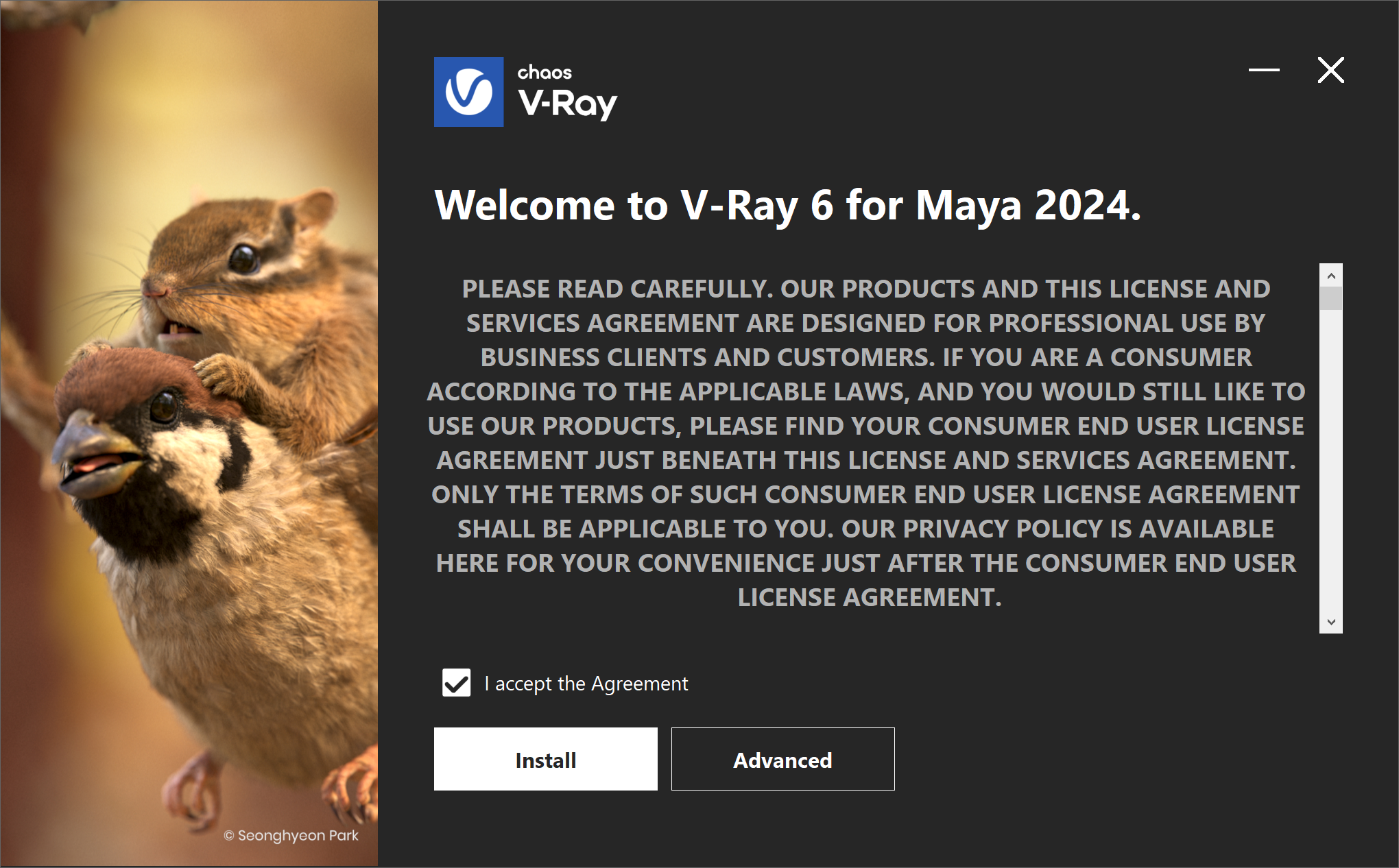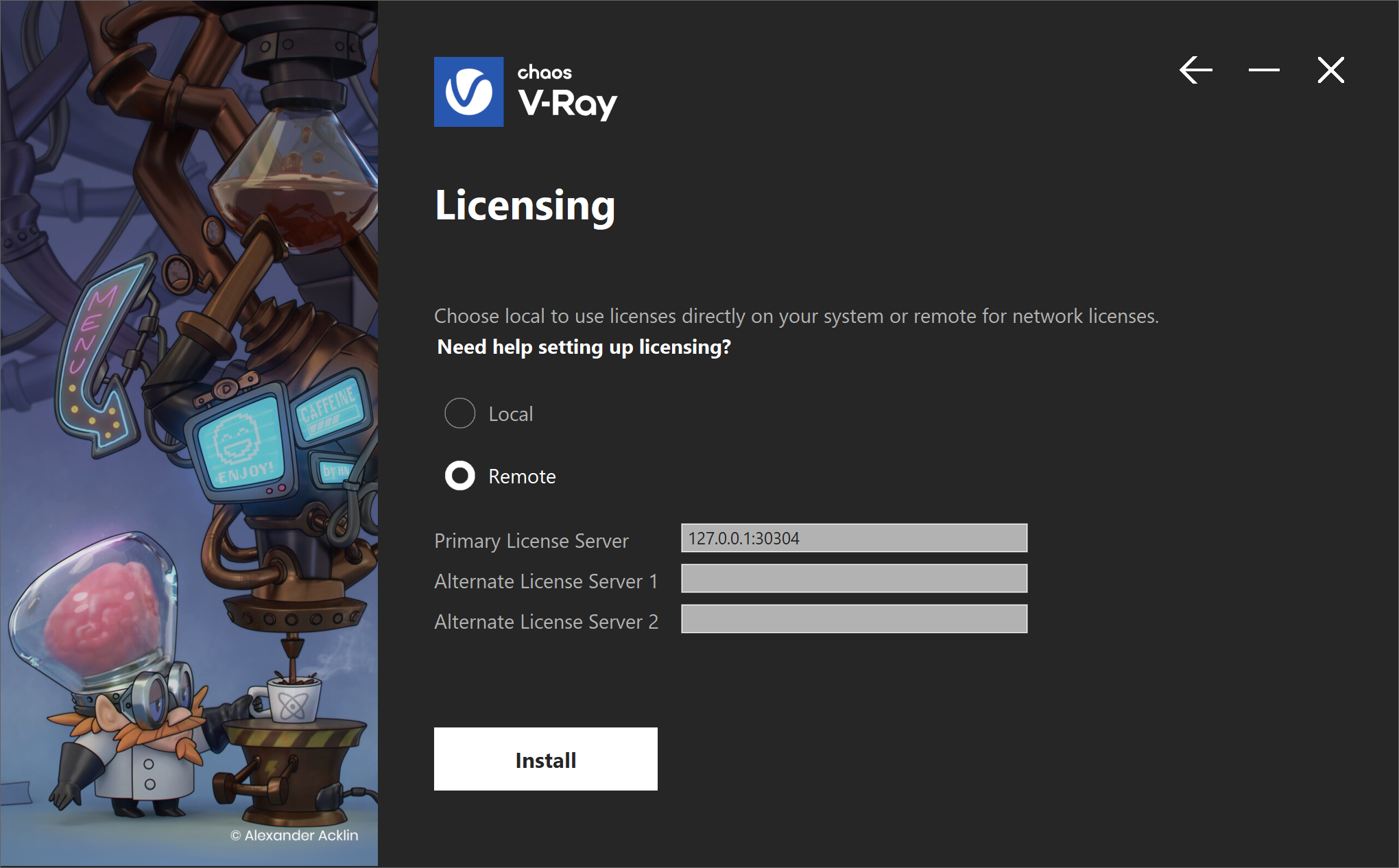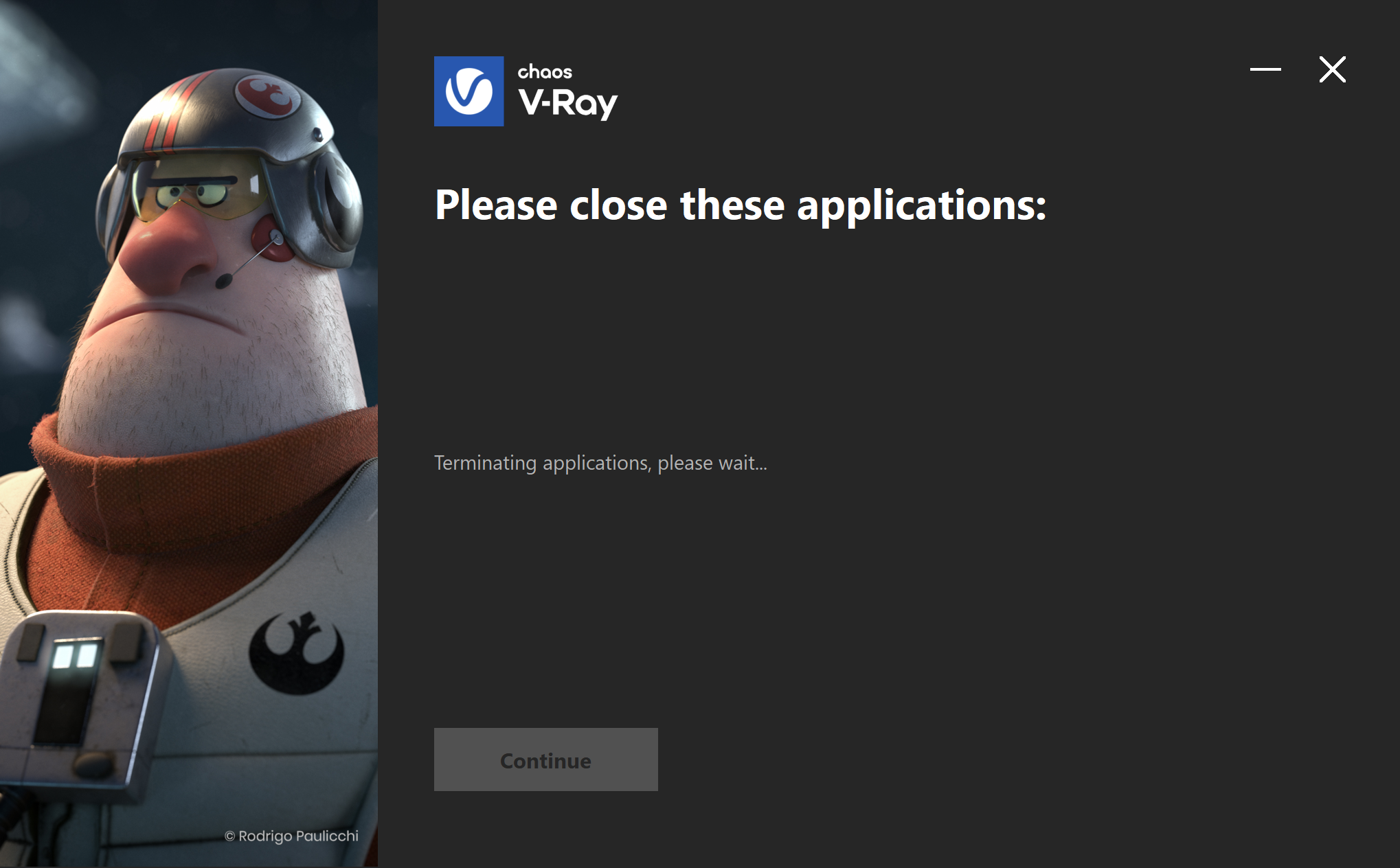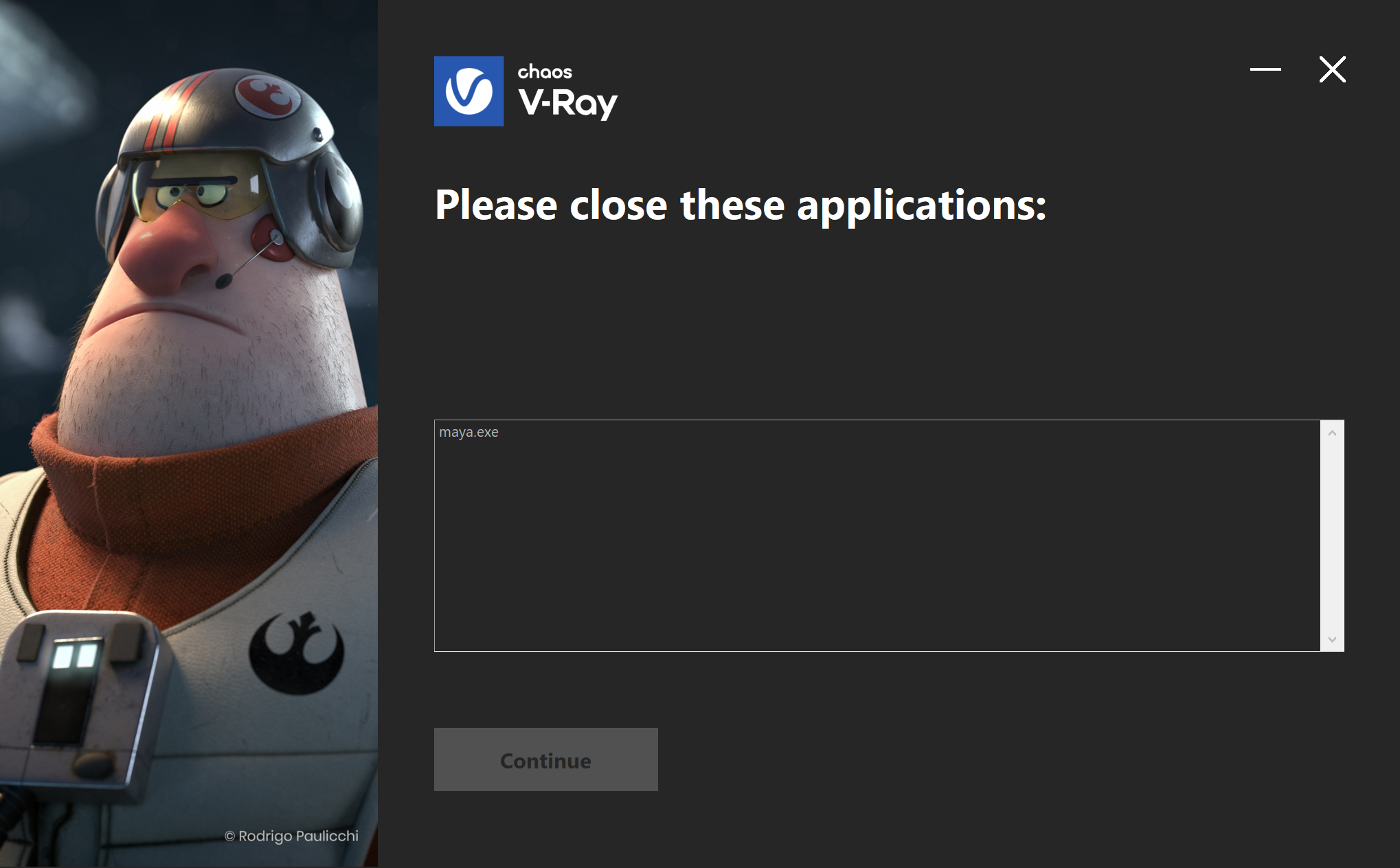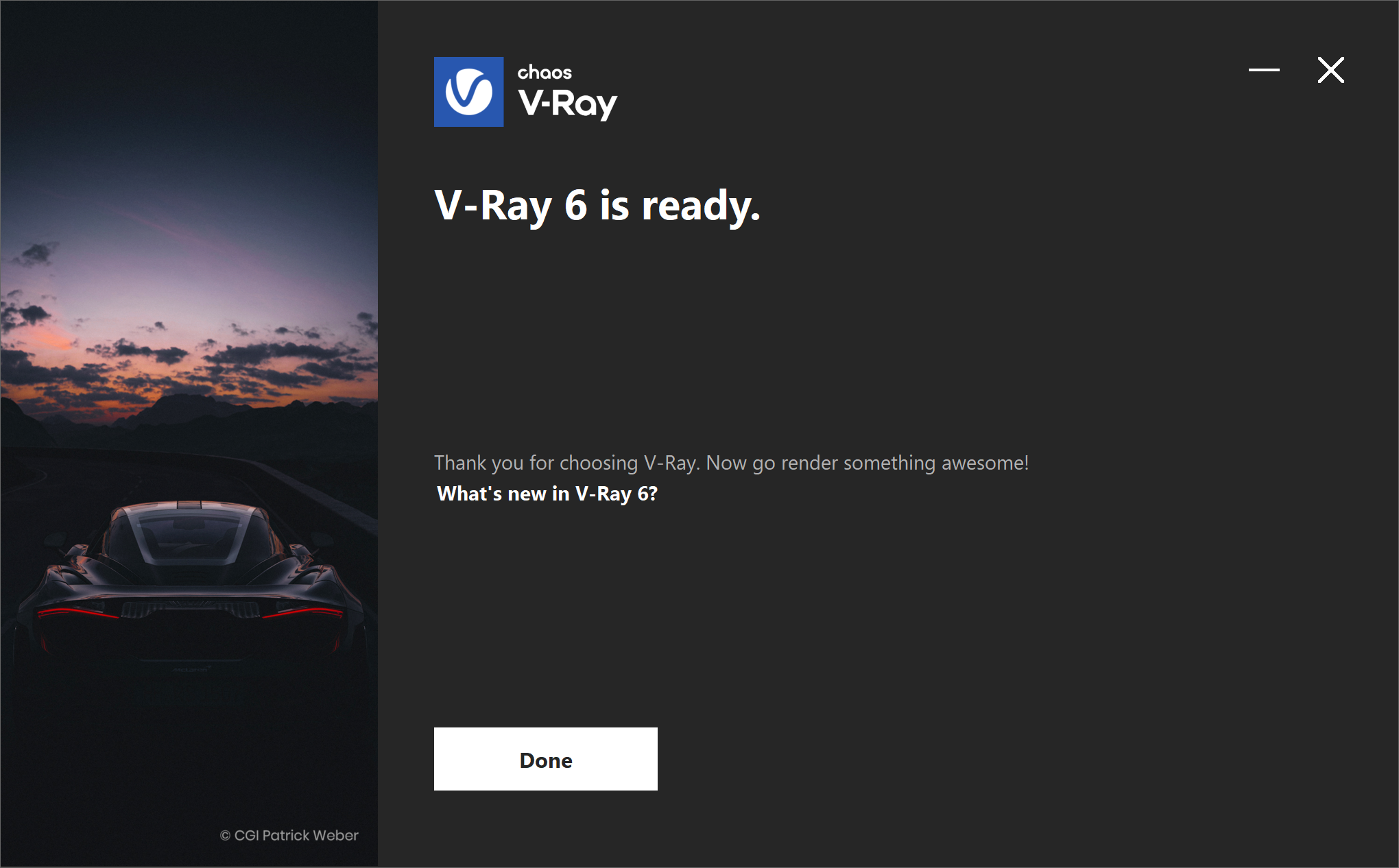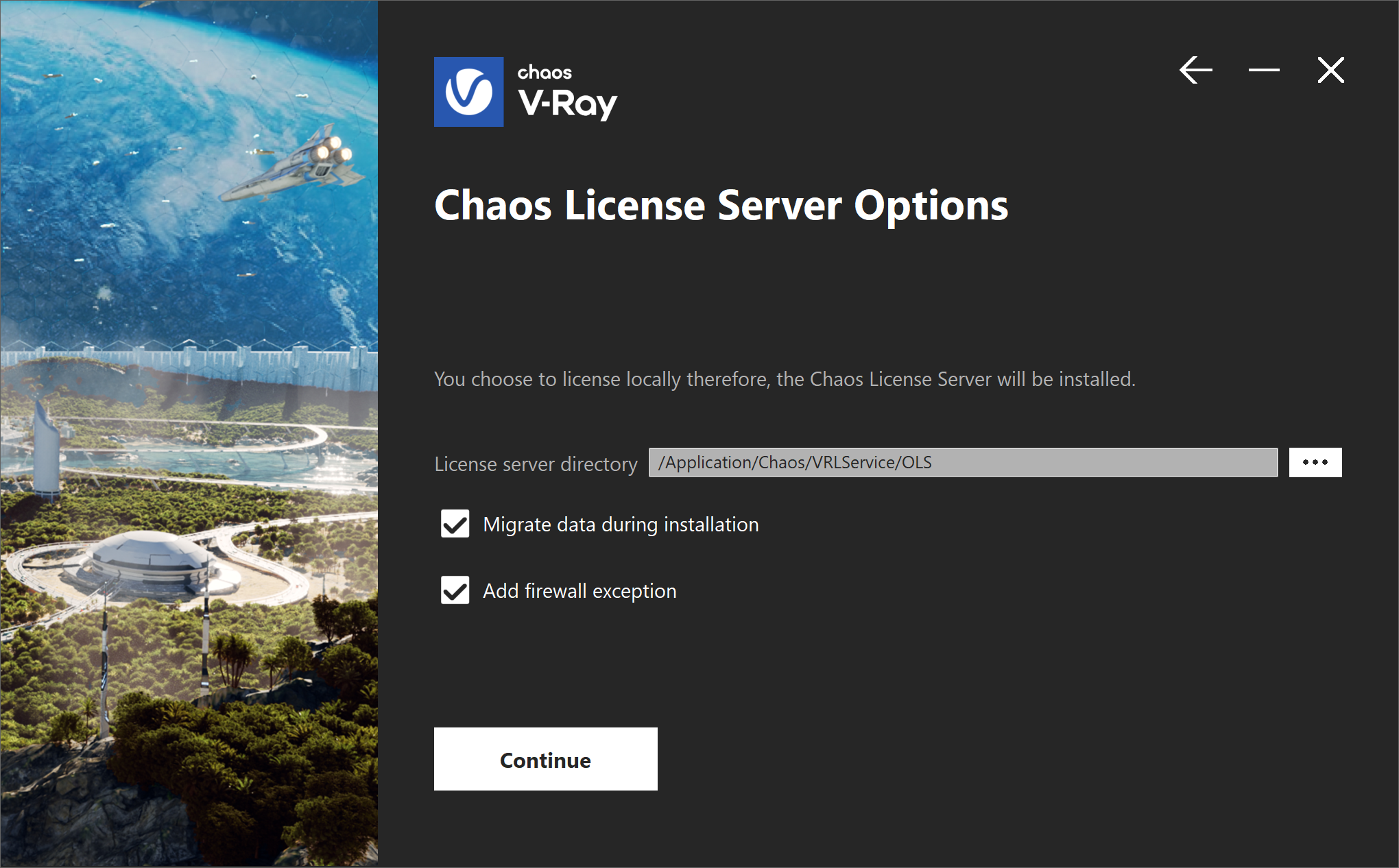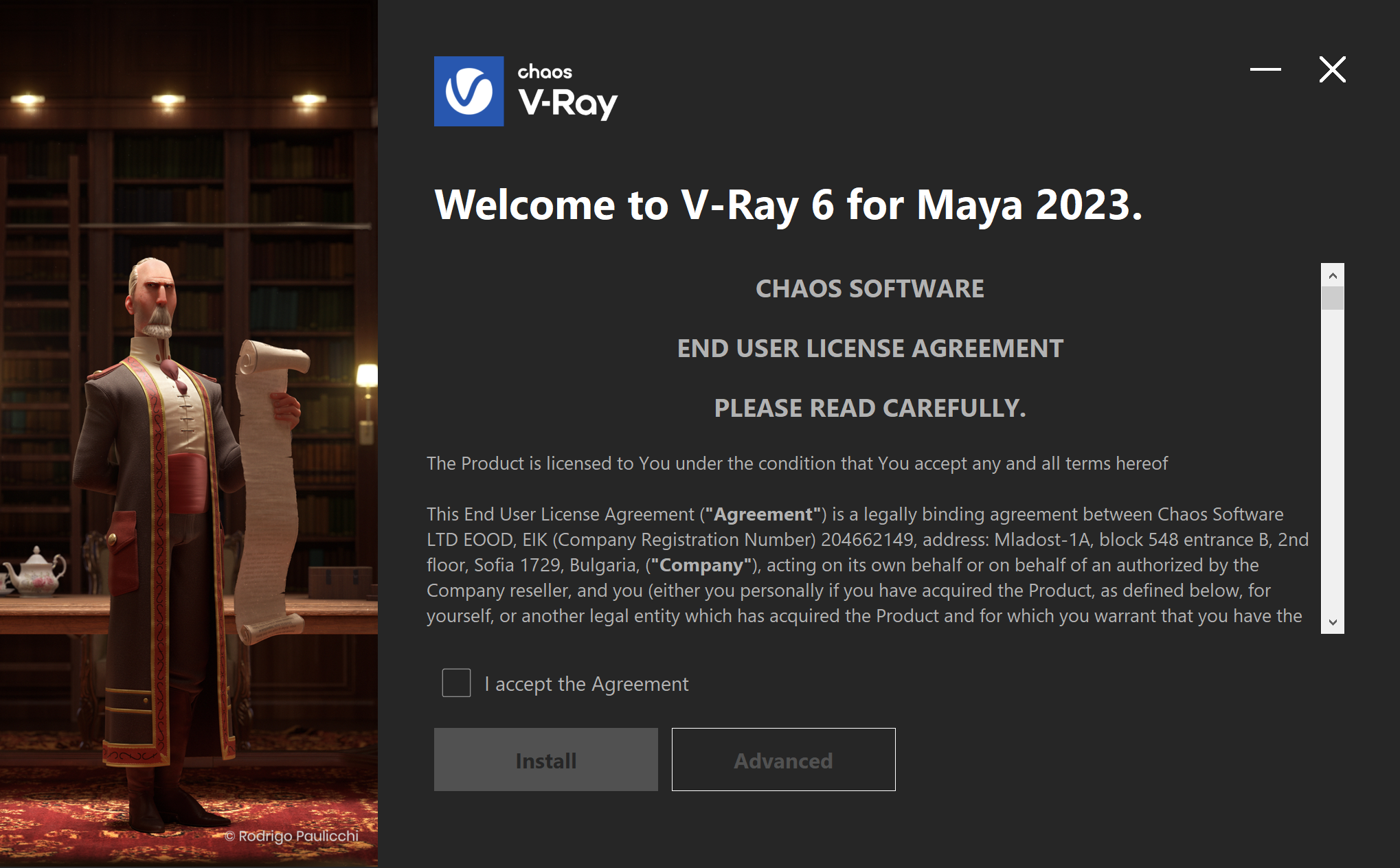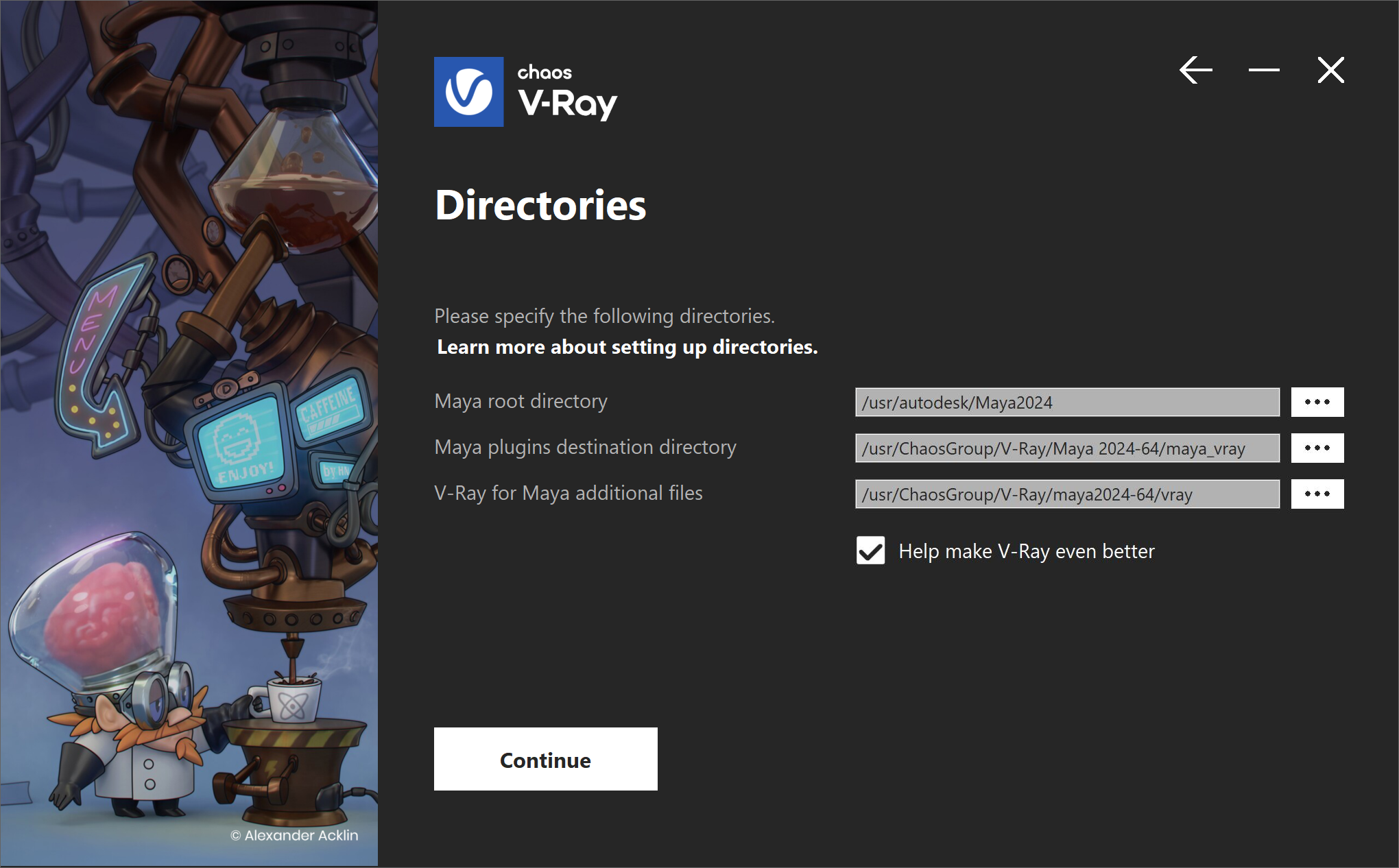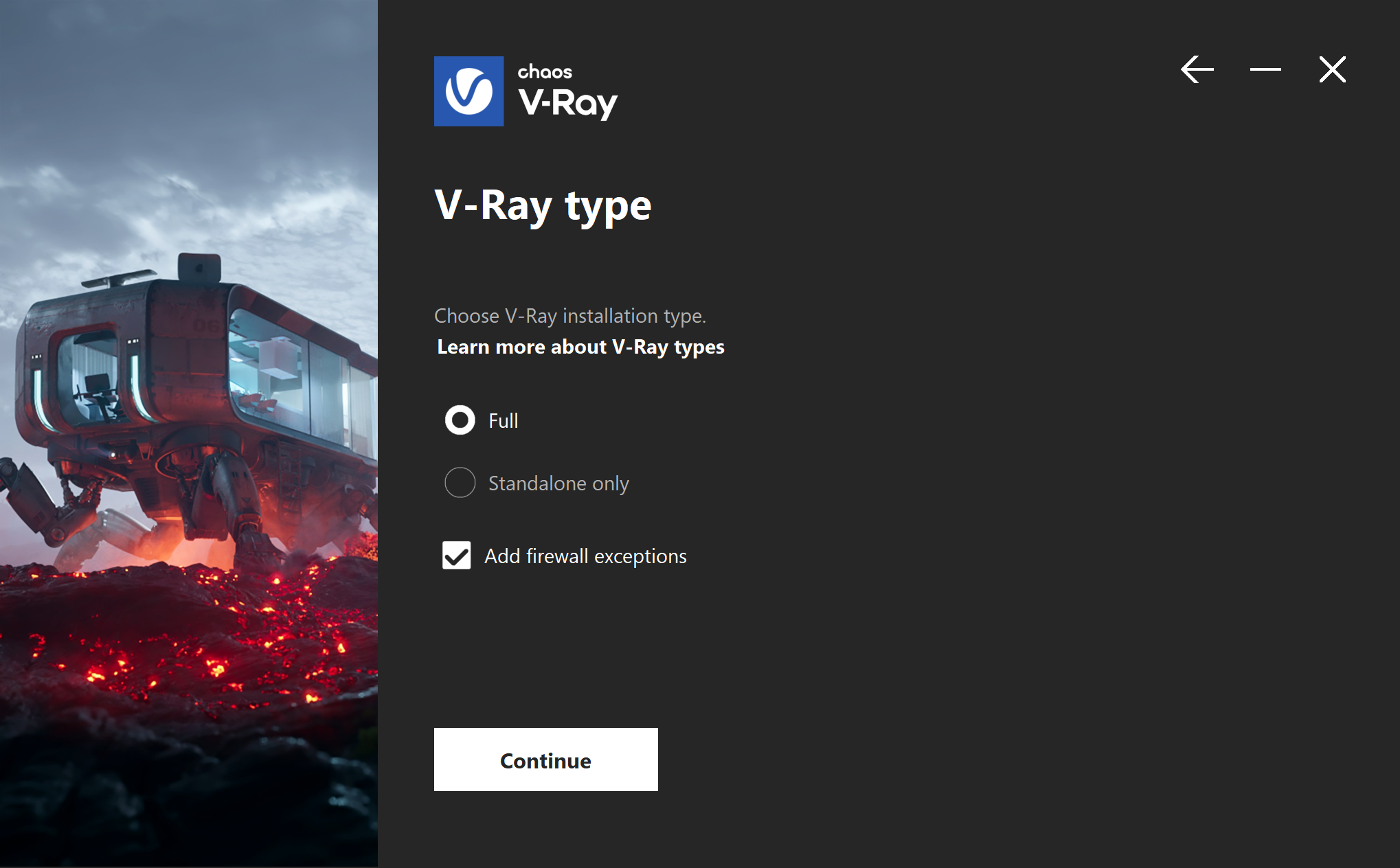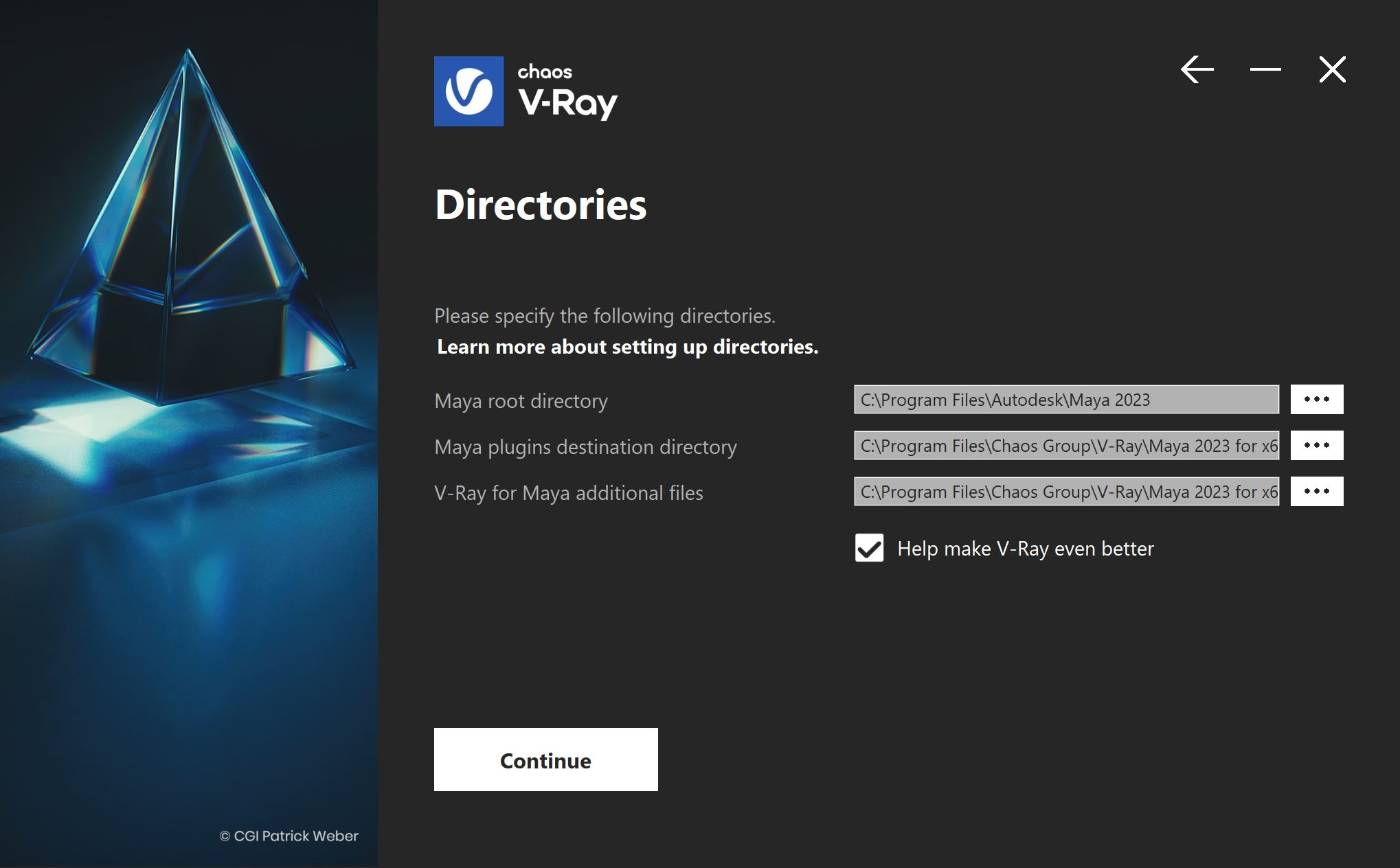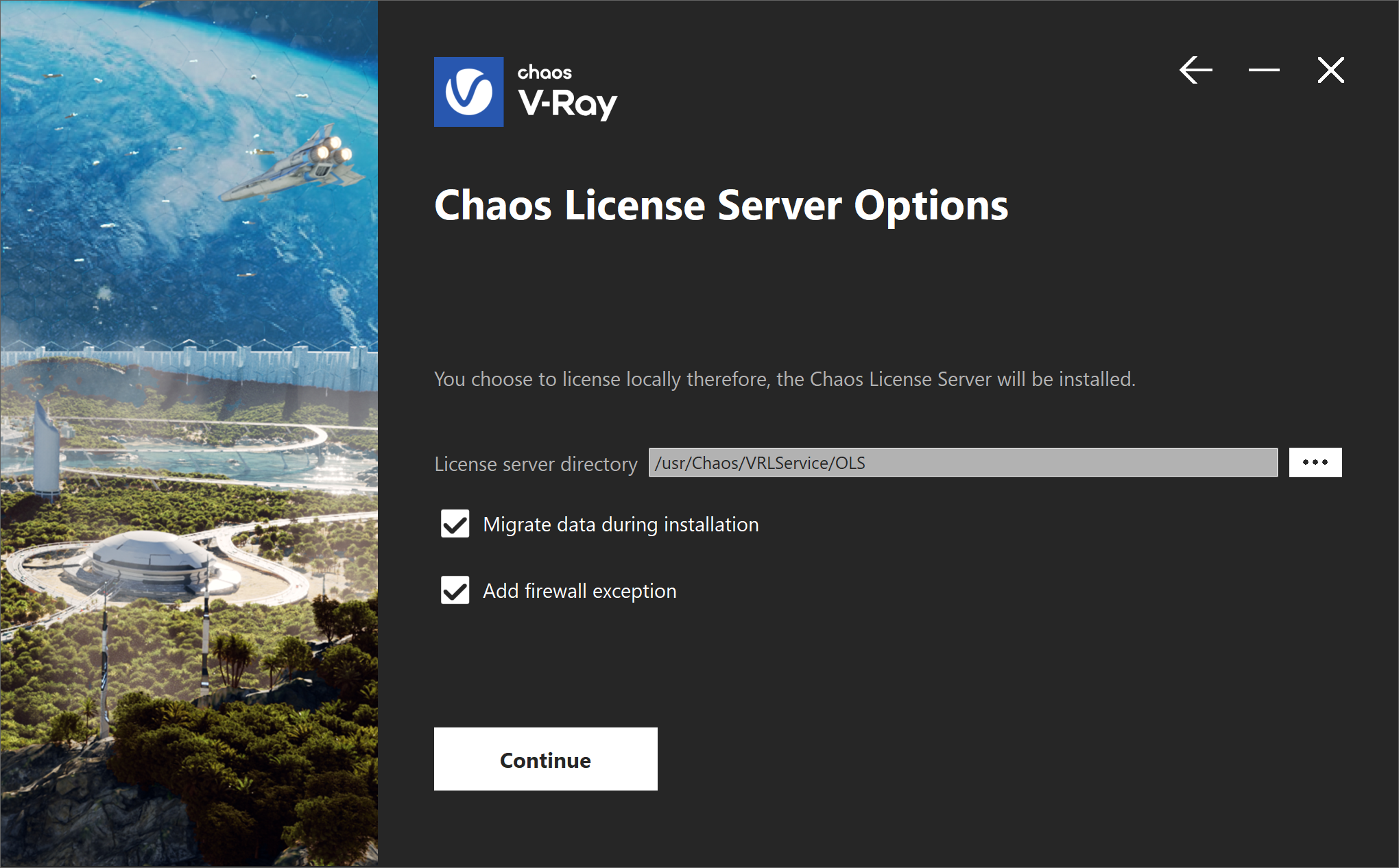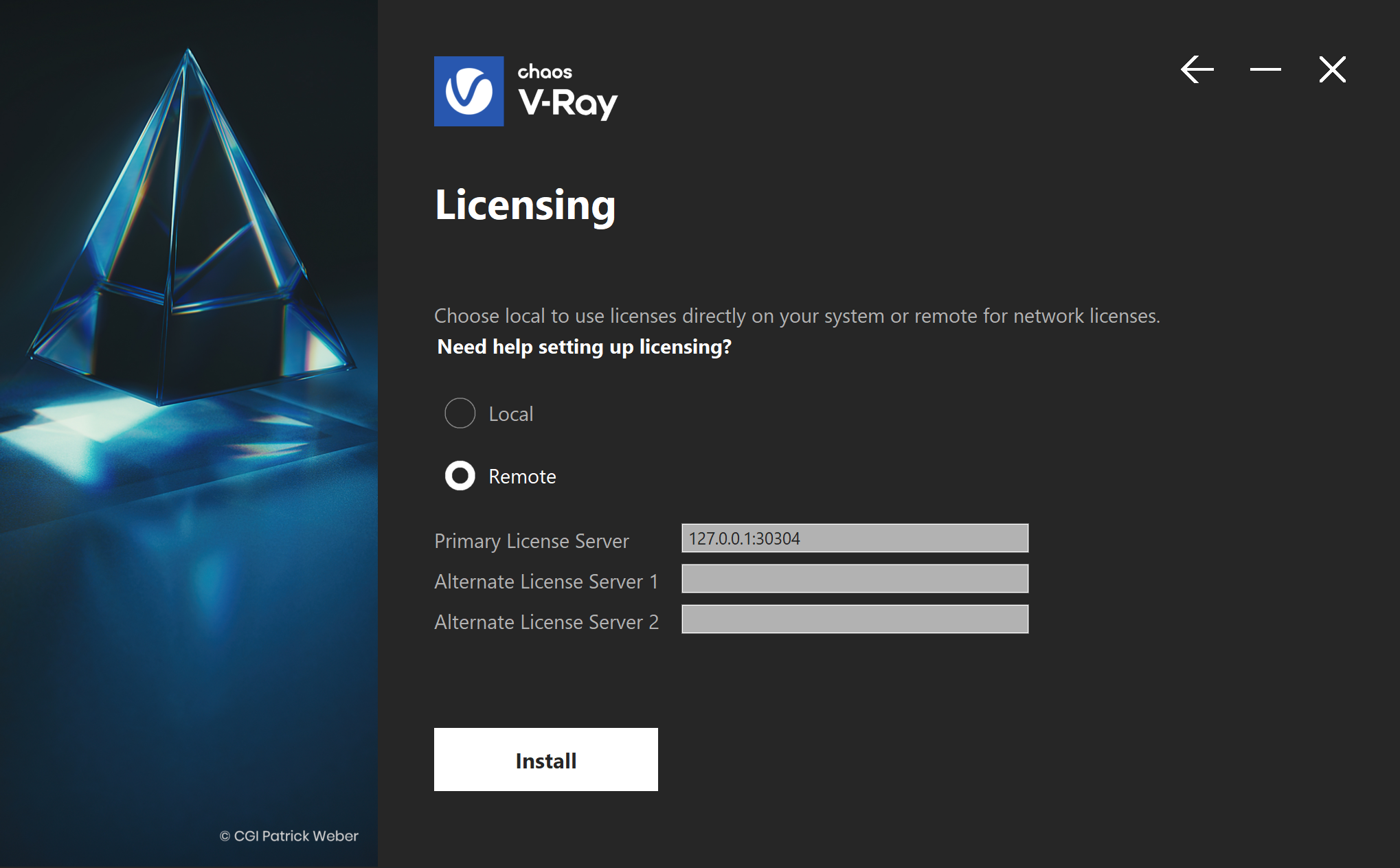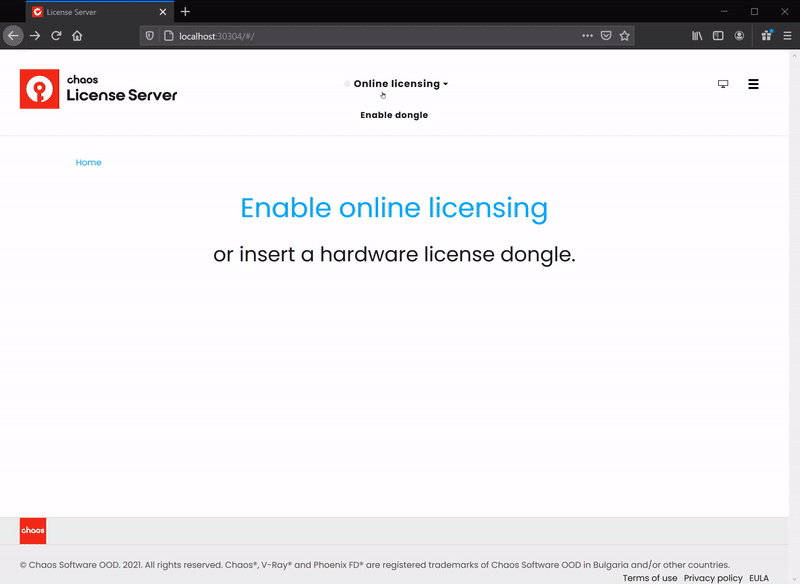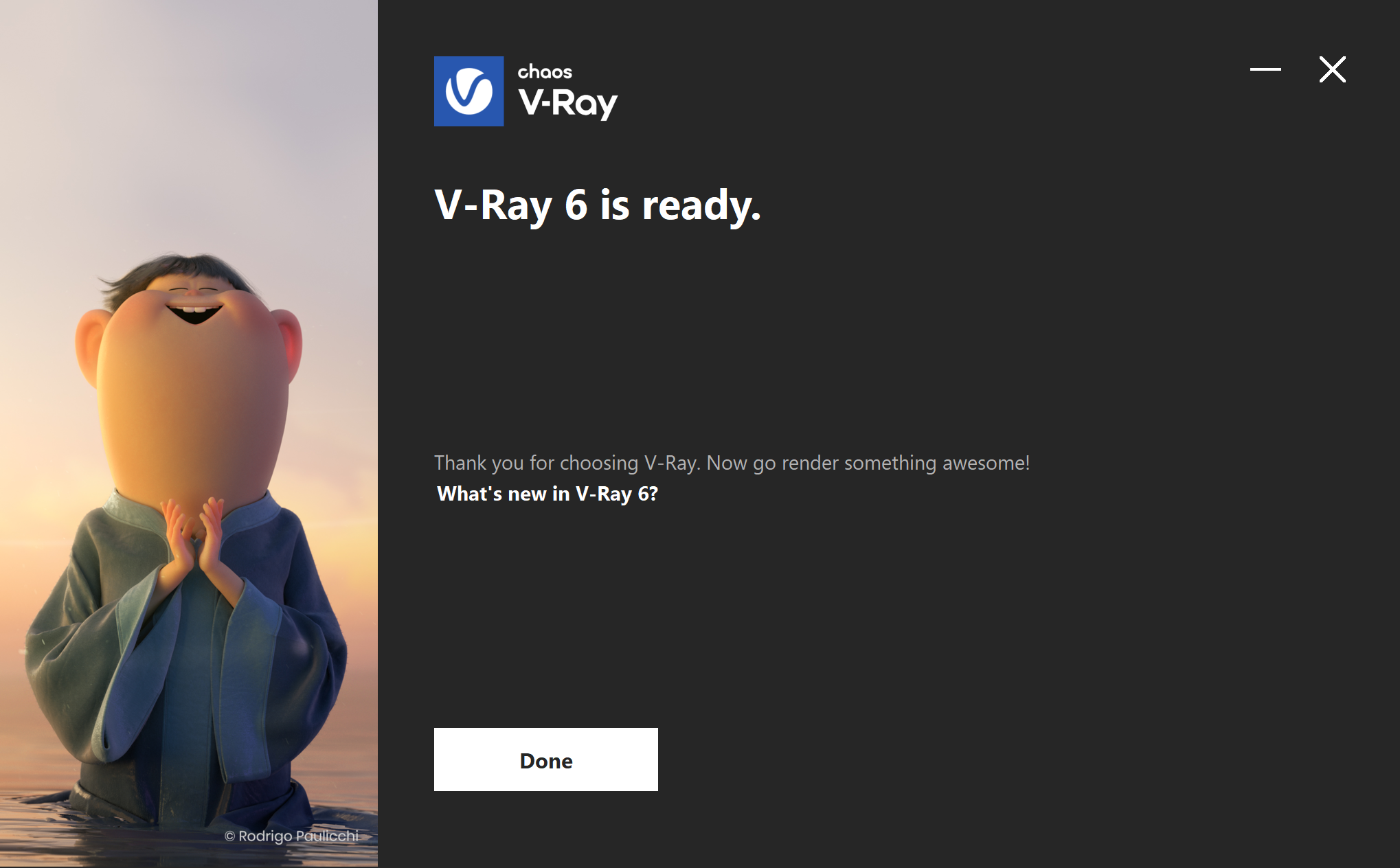Page History
This page provides information on installing To run V-Ray for Maya.
Overview
This guide is to serve as a reference for installation of V-Ray for Maya.
If you experience any problems, please check the Troubleshooting section.
A complete installation of V-Ray for Maya consists of:
| Section | ||||||||||||||||||||
|---|---|---|---|---|---|---|---|---|---|---|---|---|---|---|---|---|---|---|---|---|
|
...
, you have to:
| Progress Bar Container | ||||||||||||||||||
|---|---|---|---|---|---|---|---|---|---|---|---|---|---|---|---|---|---|---|
| ||||||||||||||||||
|
Overview
...
| Section | |||||
|---|---|---|---|---|---|
|
...
|
...
|
...
|
| UI Text Box | ||
|---|---|---|
| ||
Make sure you use the latest version of V-Ray and the License Server. |
Installing V-Ray for Maya
This section describes the installation of V-Ray for Maya using the provided installer.
| Tabs Container | ||||||||||||||||||||||||||||||||||||||||||||||||||||||||||||||||||||||||||||||||||||||||||||||||||||||||||||||||||||||||||||||||||||||||||||||||||||
|---|---|---|---|---|---|---|---|---|---|---|---|---|---|---|---|---|---|---|---|---|---|---|---|---|---|---|---|---|---|---|---|---|---|---|---|---|---|---|---|---|---|---|---|---|---|---|---|---|---|---|---|---|---|---|---|---|---|---|---|---|---|---|---|---|---|---|---|---|---|---|---|---|---|---|---|---|---|---|---|---|---|---|---|---|---|---|---|---|---|---|---|---|---|---|---|---|---|---|---|---|---|---|---|---|---|---|---|---|---|---|---|---|---|---|---|---|---|---|---|---|---|---|---|---|---|---|---|---|---|---|---|---|---|---|---|---|---|---|---|---|---|---|---|---|---|---|---|---|
| ||||||||||||||||||||||||||||||||||||||||||||||||||||||||||||||||||||||||||||||||||||||||||||||||||||||||||||||||||||||||||||||||||||||||||||||||||||
Column |
2. You will be presented with the V-Ray licensing agreement. Please take a moment to review the agreement. Once you've carefully read the End User License Agreement, you can click "I accept the Agreement" if you agree to the terms. If you need to customize your V-Ray installation, click the Advanced button. Expand |
Section | Column |
Column |
V-Ray typeThe available installation types are: Full – This is a full installation and includes all components as described in the “Installation overview” section. It will allow you to use V-Ray in Maya for Distributed or Network Rendering, to run IPR render server, use V-Ray SDK, and have V-Ray license server on this machine. Install Chaos Cloud Client – Enable this checkbox to install the Chaos Cloud client application. Chaos Cloud is a software as a service (SaaS) which allows you to submit and render scenes with cloud-based V-Ray. See more information on the Chaos Cloud page. Section | Column |
Column |
DirectoriesHere you can specify the installation paths. Please check if the default folders are correct. Help make V-Ray even better – Participate in the improvement decisions for future version of V-Ray. No intelligence property is violated when agreeing to participate in the feedback program. Chaos does not gather scenes, assets, materials, etc. What Chaos receives is user preferences on just a few key render settings and the resulting render times. The point of this feature is to improve V-Ray's performance and the user experience. This preference can be changed at any time later on from the V-Ray Render Settings > Settings > About V-Ray > Feedback program settings. For more information, see the Chaos Telemetry page. Section | Column |
Column |
LicensingIn this step, you can specify whether the V-Ray license server runs locally or on another machine. If you select the Remote option you have to fill in the IP address of your V-Ray license server in the field Primary License Server. Please leave the port 30304 unchanged. An Alternate License Server is used when the primary one does not respond. 3. If you select the Local Licensing Option, you are presented with the Chaos License Server installation. Note that if you choose Remote V-Ray license server on the network option, the License Server will skip its installation process. Section | Column |
Column |
Chaos License Server Options4. At this step you can choose the license server directory. Add firewall exception – Enabling this option allows the default licensing port (TCP 30304) in the firewall. If you disable it at this step, you will need to manually add firewall exceptions later. Section |
Column |
Then, it will uninstall any previous V-Ray versions and install V-Ray on your machine. If the installer detects any applications that need to be closed, they will be listed before being able to continue. Please close them and click Continue. Section | Column |
Column |
6. Now V-Ray is ready to render! Tabs Page |
.
|
OS Specifics
| Tabs Container | |||||||||||||||||||||||||||||||||||||||||||||||||||||||||||||||||||||||||||||||||||||||||||||||||||||||||||||||||||||||||||||||||||||||||||||||||||||||||||||||
|---|---|---|---|---|---|---|---|---|---|---|---|---|---|---|---|---|---|---|---|---|---|---|---|---|---|---|---|---|---|---|---|---|---|---|---|---|---|---|---|---|---|---|---|---|---|---|---|---|---|---|---|---|---|---|---|---|---|---|---|---|---|---|---|---|---|---|---|---|---|---|---|---|---|---|---|---|---|---|---|---|---|---|---|---|---|---|---|---|---|---|---|---|---|---|---|---|---|---|---|---|---|---|---|---|---|---|---|---|---|---|---|---|---|---|---|---|---|---|---|---|---|---|---|---|---|---|---|---|---|---|---|---|---|---|---|---|---|---|---|---|---|---|---|---|---|---|---|---|---|---|---|---|---|---|---|---|---|---|---|
| |||||||||||||||||||||||||||||||||||||||||||||||||||||||||||||||||||||||||||||||||||||||||||||||||||||||||||||||||||||||||||||||||||||||||||||||||||||||||||||||
Column |
2. You will be presented with the V-Ray licensing agreement. Please take a moment to review the agreement. Enable the I accept the Agreement checkbox and click Install to proceed with standard installation. If you need to customize your V-Ray installation, click the Advanced button. Expand |
Section | Column |
Column |
V-Ray typeThe available installation types are: Full – This is a full installation and includes all components as described in the “Installation overview” section. It will allow you to use V-Ray in Maya do Distributed or Network Rendering, run IPR render server, use V-Ray SDK, and have V-Ray license server on this machine.Standalone only – An installation which includes V-Ray Standalone and IPR render server. Please choose this option if you plan to use this machine only for Distributed Rendering with V-Ray Standalone and an IPR render server. Add firewall exceptions – Automatically adds firewall exceptions so IPR for Maya and V-Ray Standalone can run uninterrupted .
Column |
DirectoriesHere you can specify the installation paths. Please check if the default folders are correct. Help make V-Ray even better – Participate in the improvement decisions for future version of V-Ray. No intelligence property is violated when agreeing to participate in the feedback program. We do not gather scenes, assets, materials, etc. What we receive is user preferences on just a few key render settings and the resulting render times. The point of this feature is to improve V-Ray's performance and the user experience. This preference can be changed at any time later on from the V-Ray Render Settings > Settings > About V-Ray > Feedback program settings. For more information, see the Chaos Telemetry page. Section | Column |
Column |
LicensingIn this step, you can specify whether the V-Ray license server will run locally or on another machine. If you select the option Remote you will have to fill in the IP address of your V-Ray license server in the field Primary License Server. Please leave the port 30304 unchanged. An Alternate License Server is used when the primary one does not respond. 3. If you choose the Local Licensing Option, you are presented with the License Server installation. Note that if you choose Remote V-Ray license server on the network option, the License Server will skip its installation process. Section | Column |
Column |
4. At this step you can choose the license server directory. Add firewall exception – Enabling this option allows the default licensing port (TCP 30304) in the firewall. If you disable it at this step, you will need to manually add firewall exceptions later. 5. After you click the Continue button, the installer will proceed to uninstall any previous versions and install V-Ray on your machine. Section | Column |
Column |
6. Now V-Ray is ready to render! Tabs Page |
Open a terminal and navigate to the location where the installation file was saved (vray_install_dir in the example below). Ensure you have permitted Linux1. Save the installation file to a temporary folder (called vray_install_dir below); 2. Open a console and navigate to that folder; 4. Make sure you have given permission to the Installer to run as an executable. That is done with the command chmod +x. Operating system Maya version Installer name Linux 64-bit | Maya 2020 | vray_adv_61000_maya2020_centos7 | Follow the instructions of the installer.
Linux 64-bit | Maya 2022 |
Linux 64-bit | Maya 2023 |
Linux 64-bit | Maya 2024 | vray_adv_61000_maya2024_rhel8 | Some Linux GUI distributions may not be compatible with the installer's GUI. In that case, run the installation with the -gui=0 attribute.
5. Follow the instructions of the installer; if you had a previous version of V-Ray for Maya, the installer will try to automatically remove it first.
6. Upon the start of the installation, Linux may ask you for permission to run the installer with administrator privileges. Please confirm.
|
Running the Installer
| UI Steps | ||||||||||||||||||||||||||||||||||||||||||||||||||||||||||||||||||||||||||||||||||||||||||||||||||||||||||||||||||||||||||||||||||||||||||||||||||||||||||||||||||||||||||||||
|---|---|---|---|---|---|---|---|---|---|---|---|---|---|---|---|---|---|---|---|---|---|---|---|---|---|---|---|---|---|---|---|---|---|---|---|---|---|---|---|---|---|---|---|---|---|---|---|---|---|---|---|---|---|---|---|---|---|---|---|---|---|---|---|---|---|---|---|---|---|---|---|---|---|---|---|---|---|---|---|---|---|---|---|---|---|---|---|---|---|---|---|---|---|---|---|---|---|---|---|---|---|---|---|---|---|---|---|---|---|---|---|---|---|---|---|---|---|---|---|---|---|---|---|---|---|---|---|---|---|---|---|---|---|---|---|---|---|---|---|---|---|---|---|---|---|---|---|---|---|---|---|---|---|---|---|---|---|---|---|---|---|---|---|---|---|---|---|---|---|---|---|---|---|---|
Column |
10. Now V-Ray is ready to render! Some GUI Distributions of Linux may be incompatible with the GUI of the installer. In that case run the installation with -gui=0 attribute.
|
Check your License
Once the installation of the License Server is done, you are directed to the License Server local host (127.0.0.1:30304) in order to sign in and activate it.
For full information on the License Server options and settings, see the Licensing section of the documentation.
Configure V-Ray
|
Next Step
Go to step 2 to activate your Chaos License.
| Progress Bar Container | ||||||||||||||||||
|---|---|---|---|---|---|---|---|---|---|---|---|---|---|---|---|---|---|---|
| ||||||||||||||||||
| ||||||||||||||||||
| Tabs Container | ||||||||||||||||||
| ||||||||||||||||||
| Tabs Page | | |||||||||||||||||
| ||||||||||||||||||
| Tabs Page | ||||||||||||||||||
|
| UI Text Box | ||
|---|---|---|
| ||
It may be necessary to restart the terminal or, alternatively, log out and log in again so that some of the changes to the environment variables made by the installer can take effect. |
Running a V-Ray Standalone Render Server
You can use V-Ray Standalone render servers for distributed rendering, where a single frame is simultaneously calculated across many machines. Before you can use distributed rendering, you have to start the V-Ray Standalone application in render server mode on the machines that you wish to use. To do that, run the following command from a Terminal window:
Applications/ChaosGroup/V-Ray/Mayannnn/vray/bin/vrayserver
where nnnn is the particular version of Maya (2020 etc).
| title | Linux |
|---|
Loading the V-Ray for Maya Plugin
Once you have installed V-Ray for Maya, you can load the plugin from the Maya plugin Manager:
Start Maya;
Open the Plugin Manager from the Windows > Settings and Preferences > Plugin manager menu.
Scroll down to the vrayformaya plugin entry;
Check the Loaded and Auto-load options to load V-Ray for Maya.
If you do not see the vrayformaya entry, you will need to browse explicitly for the V-Ray for Maya plugin, which is called vrayformaya.so and is located by default in the /usr/ChaosGroup/V-Ray/Mayannnn-x64/maya_vray directory. The plugin will attempt to load a shared library, libvray.so, which is installed in the /usr/ChaosGroup/V-Ray/Mayannnn-x64/vray/lib folder and should be readily accessible for Maya to load without modifying the LD_LIBRARY_PATH variable.
NOTE: do not attempt to make V-Ray for Maya load the libvray.so library with the same name for the standalone version of V-Ray, which is located in the /usr/ChaosGroup/V-Ray/Standalone_for_centos7/lib/linux_x64 folder. Attempting to load the V-Ray standalone library into Maya will cause Maya to crash immediately.
Running V-Ray Standalone
V-Ray Standalone is installed as part of the V-Ray for Maya installation. It can be executed using the vray bash script which is normally installed in the /usr/ChaosGroup/V-Ray/Standalone_for_centos7/bin directory, for example:
$ /usr/ChaosGroup/V-Ray/Standalone_for_centos7/bin/vray -sceneFile="[v-ray scene file]"
Use the -help option to see a list of the available command line options.
Running a V-Ray Standalone Render Server
You can use V-Ray Standalone render servers for distributed rendering, where a single frame is simultaneously calculated across many machines. Before you can use distributed rendering, you have to start the V-Ray Standalone application in render server mode on the machines that you wish to use. This is done with the vrayserver command, for example:
$ /usr/ChaosGroup/V-Ray/Mayannnn-x64/vray/bin/vrayserver
